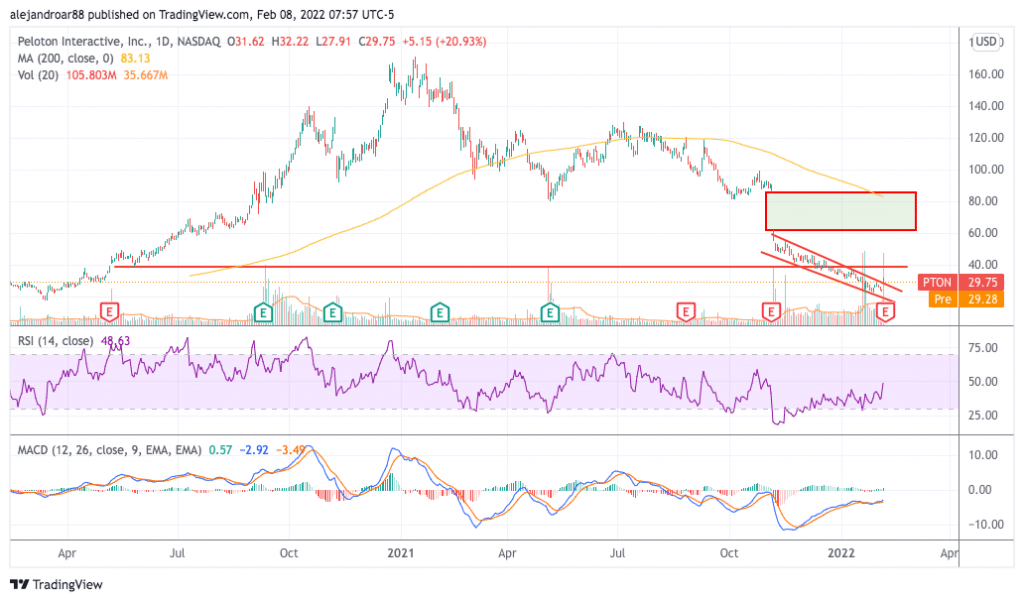Peloton Stock Down 13% Today – Time to Buy Peloton Stock?
Please note that we are not authorised to provide any investment advice. The content on this page is for information purposes only.
The price of Peloton stock is down 13% in pre-market stock trading action this morning following the replacement of its CEO John Foley and the announcement of an initiative to save costs that includes a reduction in the firm’s overhead and capital expenditures.
According to the press release published today, Foley will be replaced by Barry McCarthy – the former Chief Financial Officer of Netflix (NFLX) and Spotify (SPOT). The appointment of McCarthy will be effective on 9 February.
Moreover, Peloton outlined its plans to reduce costs and increase operational efficiency. The scheme seeks to deliver at least $800 million in annual run-rate cost savings to establish “a clear path to profitability and sustainable free cash flow”.
As part of this plan, Peloton will be reducing its headcount by 2,800 positions globally. Its roster of instructors will not be affected by the measure, the company said.
Market participants are reacting negatively to the news, possibly as these measures are indicating a strong underlying weakness in the business model instead of being a response to some short-term headwinds.
The decline is erasing most of the gains the stock experienced yesterday after an exclusive report from Reuters revealed that both Amazon (AMZN) and Nike (NKE) were exploring the possibility of making an offer to buy the fitness company.
The senior management of Peloton has been under fire lately by activity investor Blackwells Capital as the investment fund called for the removal of the company’s top executive citing that the company is now “too big, too complex, and too damaged for Mr. Foley to lead it”.
“The company is on worse footing today than it was prior to the pandemic, with high fixed costs, excessive inventory, a listless strategy, dispirited employees and thousands of disgruntled shareholders”, stated Jason Aintaby, the Chief Investment Officer of Blackwells in a letter sent to the company’s Board of Directors.
What could be expected from this fitness stock following these interesting developments? In this article, I’ll be assessing the price action and fundamentals of Peloton stock to outline plausible scenarios for the future.
68% of all retail investor accounts lose money when trading CFDs with this provider.
Peloton Stock – Technical Analysis

The price of Peloton stock has been on a sharp downtrend since January 2021 as a fading pandemic tailwind, higher manufacturing costs, and increased competition have depressed the market’s sentiment toward the company.
The steepest decline came in November last year when shares dipped more than 30% on a single day following the release of the firm’s financial results covering the first quarter of the 2022 fiscal year.
Short interest for the stock has been surging amid a confluence of negative catalysts including a spike in US Treasury yields that has resulted in a contraction in the trading multiples of companies with weak fundamentals such as Peloton.
The chart above shows that the stock is on a clear descending price channel and even though yesterday’s jump broke above this formation, it remains to be seen if today’s news will manage to change the market’s perception about the future of the firm.
Yesterday, trading volumes were quite high with more than 105 million shares exchanging hands – a figure that exceeded the 10-day average by more than 3 times.
Peloton is expected to report its financial results for the second quarter of the 2022 fiscal year today before the market opens and will hold a conference call earlier than expected to discuss these recent developments.
Even if the price trims some of today’s early losses, PTON will still have to reclaim the $40 level for the short-term outlook to turn bullish.
It is important to note that momentum indicators have posted a bullish divergence and that is a factor to consider in case the price trend suddenly changes its course.
Overall, the short-term outlook is neutral until the market takes a definite stand in regards to today’s announcements and changes.
Peloton Stock – Fundamental Analysis
In the past 12 months, Peloton lost $634 million as a result of its negative operating results and burned around $1.4 billion in cash amid mounting inventories and elevated capital expenditures.
The management’s plan to reduce costs by around $800 million and that could make the company profitable while the expected reduction of $150 million in capital expenditures should push the firm’s cash-flow generation capacity near or to positive territory.
Peloton currently holds $1.6 billion in long-term debt and capital leases on total assets of $4.4 billion including $924 million in cash and equivalents.
According to its latest annual report, the company has no major debt-related disbursements this year and this means that solvency risks are quite low.
Meanwhile, these initiatives pushed by the Board of Directors could strengthen the company’s prospects as long as the newly appointed leadership lives up to its promises.
At its current market capitalization of $9.8 billion, Peloton is trading at around 2.3 times its forecasted sales for this fiscal year. This makes Peloton a potentially appealing pick in two scenarios. First, if the company is acquired as the price paid for the firm’s shares could be substantially higher.
Meanwhile, the company could also be an appealing investment if the management team accomplishes these ambitious goals. However, Peloton’s business model has a relatively weak moat and that makes the firm’s valuation highly susceptible to the introduction of other similar products by stronger companies such as Apple (AAPL).






